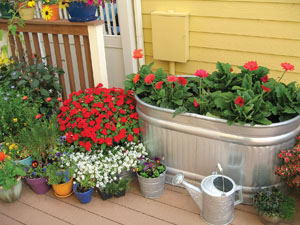Feature Garden: Everything’s Coming Up Roses
02 Mar 2011
Because almost everything is a rose in this fancier’s 50-year-old garden.
Text and garden photos by Kimberly Ezzell Ruth Roberts has finally lost count of all the roses in her yard. After planting and tending them for 50 years at her west Boulder home, “I have more roses than anybody else would want to have,” quips the spry, 83-year-old gardener. “Thousands! These days, I just tell people thousands.”
- Ruth’s garden gate is the perfect spot for a few of her many, many climbing roses. One of her favorites is the thornless climber, ‘Zephirine Drouhin’ because it’s a good performer that thrives in partial shade.

Family Roots
As a young girl, Ruth planted, tended and harvested a Victory Garden at her family’s farm 10 miles south of Iowa City. “I grew many different things, like peas, corn, potatoes,” she says. “It was a regular vegetable garden,” which fed her family in the years during and after World War II. The farm is where she and her older brother, John, learned to love plants. “He would point out roses and plants growing in other people’s yards,” Ruth recalls. But her family didn’t have much luck when it came to growing their own roses. “They got so many bugs, and the one climber we had died back so far and never bloomed because it was too cold.”
- Roses galore line every inch of Ruth’s garden. She favors modern varieties for their disease resistance, hardiness and vibrant colors. But her garden also boasts old varieties that aren’t found in nurseries these days. She also grows other perennials, annuals, bulbs and vines, like clematis
Three’s a Crowd-Pleaser
Like many rose connoisseurs, Ruth likes to apply the “rule of three”—or grouping three rosebushes in a planting. Ruth adds a twist by planting three complementary colors that intertwine indiscriminately in a pleasing bouquet, like Austin’s crimson-red ‘The Squire’ paired with pink and white blooms. Ruth also plants other perennials, choosing plants with similar soil and sun requirements and, whenever possible, planting companions with shallow roots or one large taproot so that fussy roses don’t have too much competition for nutrients. Clematis is particularly suited to climbing roses, and with many color choices it can blend in to add texture or contrast sharply for drama.
- Ruth and Shorty planted lots of trees when they bought their property 50 years ago. Now the shady retreat harbors many spots where Ruth can take a break from gardening and enjoy herself, and her plants, in her golden years.













